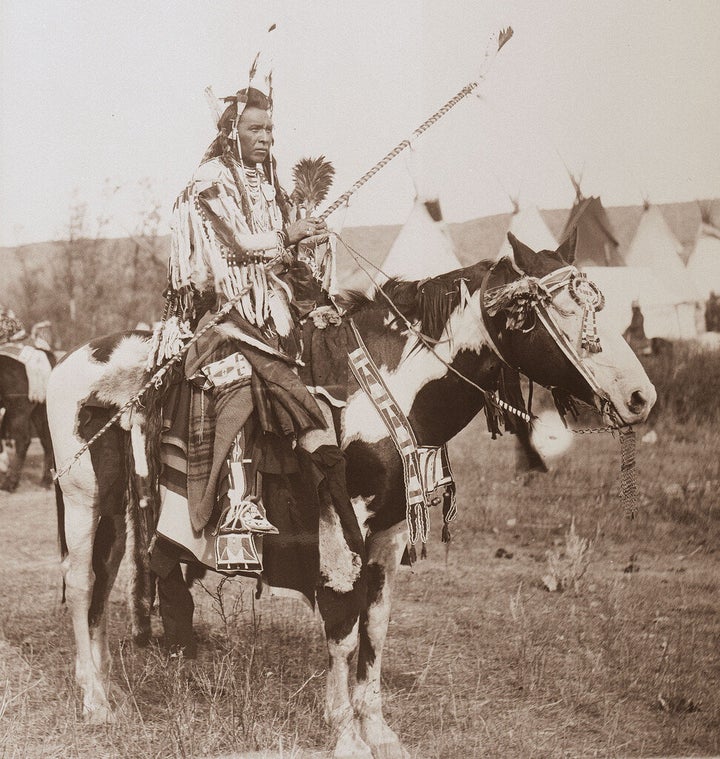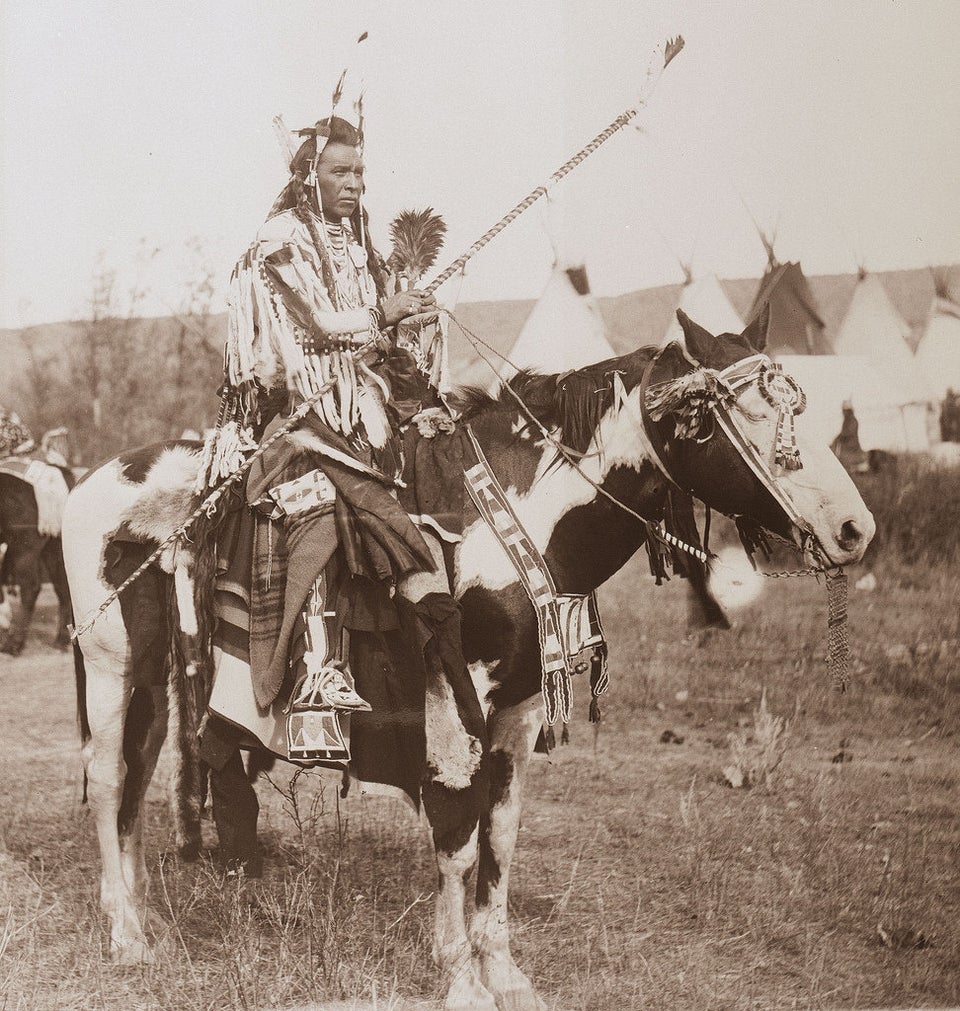
My last name, Her Many Horses, is the Lakota name of my paternal great grandmother. A more accurate English translation of her name is Many Horses Woman, meaning that she owned many horses. Among Lakota people, horses were a means of measuring wealth, but a far more important demonstration of wealth was the gesture of gifting away horses in honor of a family member. Generosity is more important than possession.
"The Fourth of July used to be a good time," Grace Pourier, my maternal grandmother, recalled. I liked to listen to her stories about what Lakota life was like in the early 1900s. She knew her Lakota ways as they had been passed on to her by her relatives. Born in 1907 on Pine Ridge Reservation and raised on Horse Head Ranch in Manderson, South Dakota, she remembered how community members and extended family gathered to celebrate with giveaways, traditional dances, parades and feasts. Later in life, she said she wished her grandmother had made her pay more attention to the events surrounding her, but at the time, she was just a kid having fun.
Much of traditional Lakota culture was threatened in the early 1900s. After the Lakota people were placed on reservations in the late 1800s, the U.S. government forbade their language and ceremonial life. Lakota people continued their traditions by incorporating traditional dances and giveaways into the Independence Day (and other American holiday) festivities in which they were encouraged to participate. For this reason, Fourth of July celebrations became something to look forward to. After Lakota men joined the military to fight in World War I, the use of the U.S. flag in beadwork and quillwork took on a new meaning. Today, if a bead worker uses the flag design, he or she is probably a veteran or a family member of someone who has served in the military.
In the early years of my grandmother's youth, horses still played an important role in the lives of the Oglala Lakota people. Since their introduction to the region in the early 1700s, horses had revolutionized Plains cultures. But they were more than work animals; horses were, and still are, cherished. The Pourier family was known for its racehorses. During the reservation period of the early 1900s, beautiful beaded horse head covers, saddle blankets and saddlebags were made to decorate favorite horses on special occasions, such as the Fourth of July parades. Horses were often given away at naming ceremonies, memorial ceremonies (held a year after a family member's death), and giveaways (which might celebrate a returning veteran or honor a graduating student). Traditional giveaways centered on the giving away of horses, money, clothing, blankets and other material objects. Hosting a giveaway today involves tremendous preparation, including the gathering of gifts, such as brightly colored star quilts, Pendleton blankets and handmade shawls, as well as feeding the whole community.
Continue reading below the slideshow:
Grandma Grace once told me that her grandmother really knew Indian ways: "Grandpa Pourier would have been a rich man, but Grandma Pourier kept giving the horses away." A horse to be given away would be brought into the Fourth of July dance arbor or other community gathering, while men on horseback waited outside. The horse was shown to the people or paraded inside the arbor, then taken outside, given a slap on the rump, and released. The man on horseback fortunate enough to catch the freed horse became its proud new owner.
My grandmother also remembered that women would give away dresses made of tanned deer hide, with the yoke of the dress completely covered with beadwork. "They would take off their beaded dresses right there in the dance arbor and give them away." The women giving the dress away wore a cloth dress beneath the beaded dress. Giving away a fully beaded dress in honor of a relative was a tremendous act of generosity. The person receiving the valuable gift would shake hands with the giver and with the relative being honored.
Emily Her Many Horses, my paternal grandmother, remembered receiving her Lakota name at about age 10. She wore a wool dress embellished with many elk teeth, valuable because only two of each elk's teeth -- the incisors -- are used for decoration. They are natural ivory. Along with this dress, she wore beaded moccasins and leggings, and after the naming ceremony, she was told to give away the dress, moccasins and leggings. She struggled to keep the dress, but her parents made her part with it -- at such a young age, she did not understand what this act of generosity meant, and she wondered why her grandfather had her shoes, which were tied together by their shoestrings and thrown over his saddle horn. Her grandfather gave away five horses that day in her honor.
Leo Her Many Horses, my father, was given a horse at a Hunka Lowanpi, a naming ceremony head during a Sun Dance. He received a wooden stick that had attached to it a rawhide cutout of a horse. This meant that he would later receive the actual horse. The Hunka Lowanpi is a Lakota naming/adoption ceremony. It creates a kinship relationship that is respected by all the family members involved, and it is at this ceremony that Lakota names are given. The family of the person receiving the name will ask a well-respected individual to name its relative. The person naming the individual will pray with an eagle feather and then tie the feather in that person's hair. The names given at a Huna Lowanpi are used only on special occasions -- to have one's name sung publicly in a song is considered a great honor. The person whose name was sung by his or her family members will give away money, horses or blankets for this honor.
Often on Memorial Day or after a death, people will place articles of clothing, bowls of fruit, packs of cigarettes, or other such items on the grave of a family member. These things are put out with the idea that other people are welcome to come by and take them. This act is performed to honor the deceased family member. My father said that one method of giving away was to place the horse outside the cemetery with the reins left hanging loose to signify that anyone was welcome to take it.
In the collection of the National Museum of the American Indian, there is a beautiful, elaborately beaded horse head cover used at a 1904 Fourth of July parade at Pine Ridge, where my grandmother would be born three years later. The catalog information states that this horse head cover was collected by J.W. Good and was "used by chief of Teton Sioux to lead parade." Imagine the horse that wore this, the white beads glinting in the July sun.
It's a wonderful piece of artistry in its geometric design and lazy-stitch technique, but what's unique about it is that it appears to have been made with the intention of later being recycled into many different objects. The beaded section, which would be placed over the face of the horse, could be remade into a pair of women's beaded leggings, and the area over the horse's cheek could be made into a pipe bag. The upper neck section of the cover would have been made into a pair of tipi bags, also known as a "possible bag," because anything possible was stored inside. The lower neck section could be made into a pair of moccasins.
The resourceful woman who created this horse mask obviously had future plans for it -- plans that were, fortunately for us, never carried out. A fusion of gifts never given, it is a reminder of Lakota traditions pieced together, a silent testament to what lies hidden within all those Fourths of July.
Emil Her Many Horses (Oglala Lakota) is an associate curator at the National Museum of the American Indian and the lead curator for "A Song for the Horse Nation." He lives in Washington, D.C.
This excerpt was reprinted with permission from the book, "A Song for the Horse Nation", published by the Smithsonian's National Museum of the American Indian. The exhibition of the same name is on view in Washington, D.C. until January 7, 2013.
